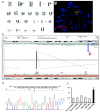IGH rearrangement in myeloid neoplasms
- PMID: 32165485
- PMCID: PMC7271583
- DOI: 10.3324/haematol.2020.246744
IGH rearrangement in myeloid neoplasms
Figures


References
-
- Rovigatti U, Mirro J, Kitchingman G, Dahl G. Heavy chain immunoglobulin gene rearrangement in acute nonlymphocytic leukemia. Blood. 1984;63(5):1023–1027. - PubMed
-
- Qiu Y, Korteweg C, Chen Z, et al. Immunoglobulin G expression and its colocalization with complement proteins in papillary thyroid cancer. Mod Pathol. 2012;25(1):36–45. - PubMed
-
- Qiu X, Sun X, He Z, et al. Immunoglobulin gamma heavy chain gene with somatic hypermutation is frequently expressed in acute myeloid leukemia. Leukemia. 2013;27(1):92–99. - PubMed
Publication types
MeSH terms
LinkOut - more resources
Full Text Sources
Medical

